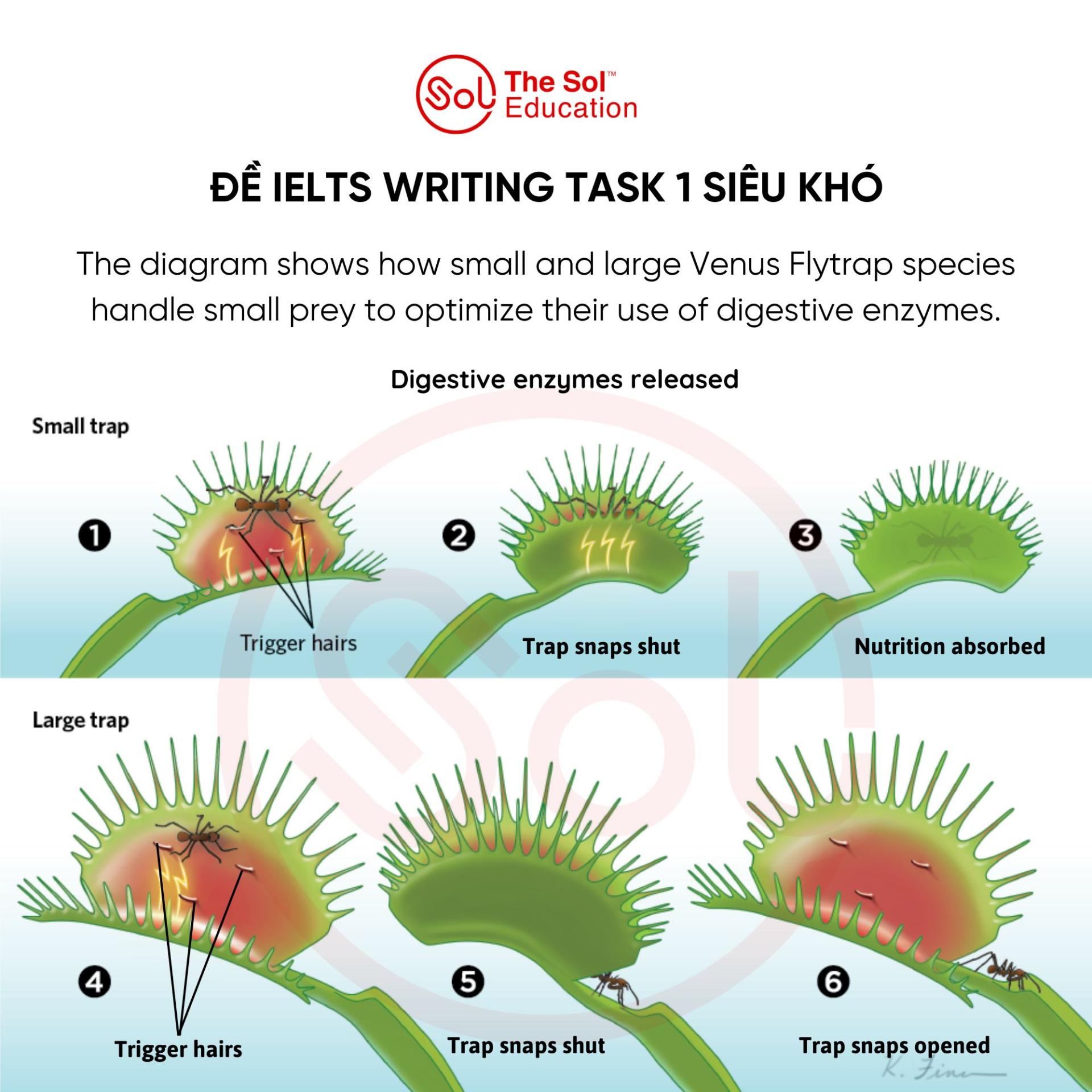
Đây thực sự là một đề bài rất khó vì các thông tin không rõ ràng, nhất là quá trình hoạt động của large venus flytrap. Điều này rất đánh đố thí sinh nếu chúng ta chưa biết về cách thức hoạt động thực tế của loài cây này.
Để hiểu hơn về process trên, chúng ta sẽ làm rõ hoạt động của cây venus flytrap nhé.
Đây là một loại cây thường ăn côn trùng, nhện để bổ sung chất dinh dưỡng. Ở hình dạng thông thường, venus flytrap chia thành 2 phần mở rộng sang 2 bên. Chúng có những trigger hairs, khi con mồi bò vào trong bẫy và chạm vào những sợi lông này, các trigger hairs sẽ kích hoạt cơ chế để cây đóng nắp lại. Bẫy sẽ đóng thật chặt để bắt đầu quá trình tiêu hóa con mồi, hấp thụ chất dinh dưỡng, và quá trình này mất đến khoảng 1 tuần.
Do quá trình tiêu hóa con mồi rất lâu và tốn nhiều năng lượng nên các cây venus flytrap cũng sẽ có những điều chỉnh để chọn lọc con mồi phù hợp. Và đó chính là quy trình mà chúng ta thấy trong đề bài:
Với bài này, các bạn vẫn làm theo cấu trúc bài thông thường cho tất cả các dạng bài IELTS Writing task 1:
The SOL tặng các bạn một vài bài mẫu tham khảo cho đề bài trên nhé:
Sample answer 1:
The diagram illustrates the contrasting mechanisms employed by small and large Venus flytrap species to digest small prey, maximizing digestive enzyme efficiency. The process can be broadly categorized into two distinct phases, differing significantly in their trigger response and subsequent digestive actions based on the prey-to-plant size ratio. Smaller plants exhibit a complete closure response, while larger plants may only partially close, impacting the digestion process.
In smaller Venus flytraps, the trigger hairs play a crucial role in prey capture and digestion. When a small insect, such as an ant, contacts these hairs, it triggers a stimulation process. Sufficient stimulation causes the trap to snap shut, enclosing the prey. Enzymes are then released, dissolving the prey, and the plant absorbs the resulting nutrients.
Larger Venus flytraps exhibit a different response to small prey. While contact with the trigger hairs still initiates a reaction, the smaller area of stimulation may be insufficient to trigger a complete closure. Consequently, the trap may only partially close or reopen shortly after, allowing the prey to escape. This strategy avoids wasting digestive enzymes on prey too small to provide a significant nutritional benefit.
(188 words)
Sample answer 2:
The provided diagram details the contrasting mechanisms employed by small and large Venus flytraps in processing small prey, highlighting their strategies for efficient enzyme utilization. Overall, the process is fundamentally determined by the size differential between the plant and its potential meal.
Smaller Venus flytraps, upon prey contact with their trigger hairs, initiate a rapid closure mechanism. This response, triggered by sufficient sensory input from the hairs, effectively traps the insect. Subsequently, the plant releases digestive enzymes, breaking down the prey. The resulting nutrients are then absorbed by the plant, maximizing the benefit from the captured insect.
Conversely, larger Venus flytraps demonstrate a more discerning approach. While contact with trigger hairs still elicits a response, the smaller relative size of the prey generates insufficient stimulation for complete trap closure. This results in a partial or temporary closure, often allowing the small prey to escape. This selective digestion strategy conserves the plant's limited supply of digestive enzymes, preventing their wasteful deployment on nutritionally insignificant prey.
(164 words)
SOL tặng thêm các bạn một số từ vựng hữu ích để vượt qua đề bài task 1 về cây bắt ruồi này nhé:
| Từ vựng | Word type | Nghĩa |
| Carnivorous | Adj | Ăn thịt |
| Predatory | Adj | Ăn thịt, săn mồi |
| Insectivorous | Adj | Ăn côn trùng |
| Trap mechanism | NP | Cơ chế bẫy |
| Trigger mechanism | NP | Cơ chế kích hoạt |
| Digestion process | NP | Quá trình tiêu hóa |
| Enzyme activity | NP | Hoạt động của enzyme |
| Nutrient uptake | NP | Sự hấp thu chất dinh dưỡng |
| Prey capture | NP | Việc bắt mồi |
| Adaptive strategy | NP | Chiến lược thích nghi |
| Resource allocation | NP | Sự phân bổ tải nguyên |
| Metabolic efficiency | NP | Hiệu quả trao đổi chất |
| Secretion | N | Sự tiết ra |
| Stimulus | N | Kích thích |
| Response | N | Phản ứng |
Hy vọng thông qua bài viết này, các bạn sẽ không còn thấy hoảng sợ khi gặp một đề bài khó như Venus flytrap trong phần thi IELTS Writing task 1 sắp tới.
Chúc các bạn đạt aim!
